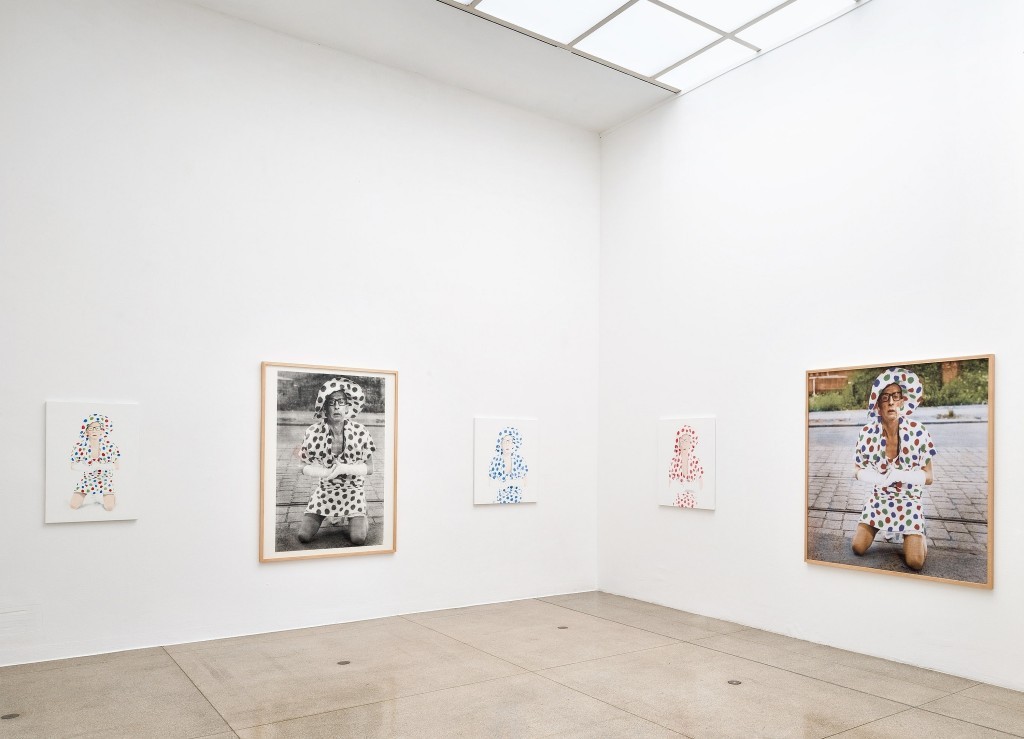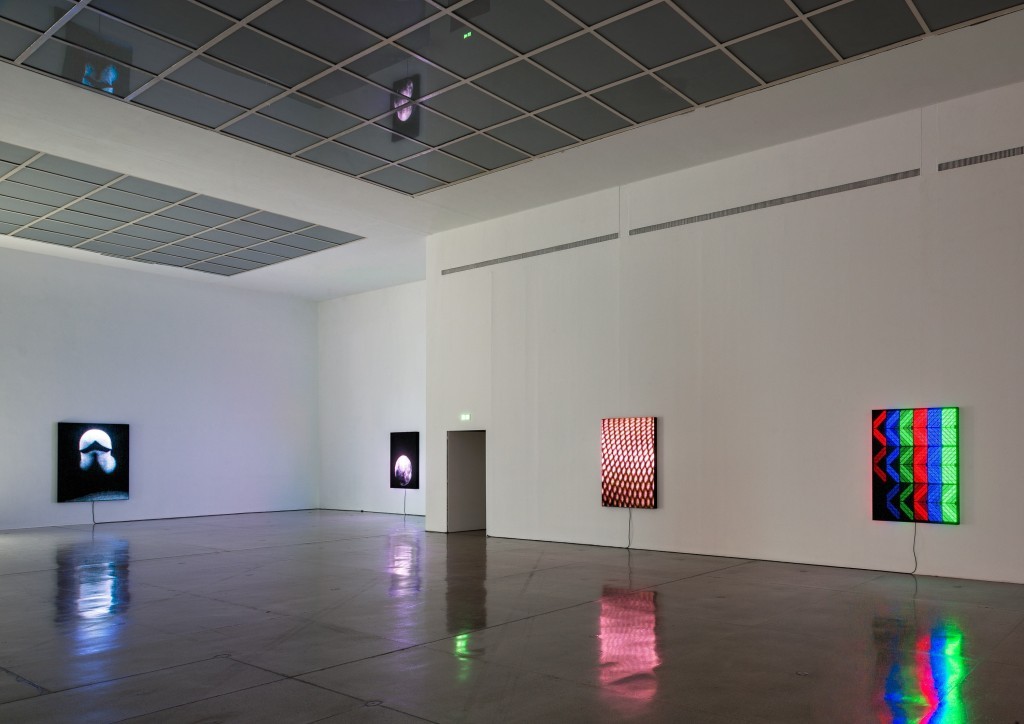Mark Leckey + Alessandro Raho
We Transfer
11 Sep - 01 Nov 2015

Mark Leckey + Alessandro Raho, We Transfer, installation view, Secession 2015, Photo: Iris Ranzinger
MARK LECKEY + ALESSANDRO RAHO
We Transfer
11 September – 1 November 2015
Curator: Jeanette Pacher
We Transfer, Mark Leckey’s first solo show in Austria, focuses on the notion of transformation, conversion, transcendence. The simultaneity of different modes of existence (virtual vs. real), or of consciousness, that is significant for the present networked digital era is an issue inherent in a number of works by this British artist, whom the Guardian recently labelled ‘the artist of the YouTube generation.’ Leckey counters the view that smart technologies and an ever denser network of algorithms increasingly rationalises us users and transforms us into inhuman cyborgs with an alternative account: the network and its coordinates, he proposes, in fact engender a chaotic irrationalism, an unconscious. Everyone has his or her own individual—and, as the artist puts it, “autistic”—grid in which images, information, and recollections are stored.
Selected images from Mark Leckey’s personal grid are on display in the Secession’s main gallery. Short animations flicker across ten LED screens in endless loops—fluid visual ‘teasers’ such as a scene from Disney’s Pinocchio, a drag queen, the full moon, an ecstatically dancing teenager, a map visualizing Great Britain’s nocturnal illumination, a blown-up RGB grid, a figure that seems to mutate into an amorphous body... One recurrent motif is the dot, surfacing variously as the red, green, and blue points of light in the LED display’s matrix, marks on the light pollution map, the circular disk of the moon, the raster dots of a print, or a fabric pattern.
The exhibition’s key figure is a middle-aged man in a polka-dot dress and hat, kneeling on the pavement in supplication—a gesture that recalls icons of saints or martyrs. For Leckey, this scene from Billy Wilder’s screwball comedy 1, 2, 3 (1961) perfectly embodies the ecstatic moment of transition. In the exhibition, the image of Polka Dot Man isolated from the movie develops a life of its own. Variations on the motif appear in formats including large prints, a psychedelic GIF animation on one of the LED screens, a moving still in a new video, and a series of oils on canvas by Alessandro Raho. At Leckey’s invitation to show his work at the Secession, Raho created an arrangement in the Grafisches Kabinett that integrates this figure and five other pictures in a sort of family portrait. A rather striking feature of the paintings is the attention the artist has devoted to the clothes of his “sitters”: T-shirts printed with cartoon characters as well as an extravagantly patterned pantsuit effectively function as pictures within the picture.
In a screening room set up in the main gallery’s right wing, Louise Bourgeois’ Nature Study (1984) is subjected to a disturbing experiment. Degradations (2015) uses 3D animation to set the flesh-coloured figure in motion and highlight the strange inertia of its rubbery physicality. Twice a day, a selection of videos including Fiorucci Made Me Hardcore (1999), March of the Big White Barbarians (2005), and Three Minute Wonders—Turner Prize (2008) is screened here, too.
Mark Leckey’s highly idiosyncratic work combines installations, objects, videos, and sound sculptures with popular culture, in particular British subculture. In his iconic video Fiorucci Made Me Hardcore (1999), he compiled found footage from 1970s Northern Soul to Rave in the late 1990s, thus creating a visual essay on over twenty years of dance culture in England. In exhibition projects such as The Universal Addressability of Dumb Things (Hayward Touring, UK, 2013) or Lending Enchantment to Vulgar Materials (WIELS, Brussels, 2014), he explores the cultural identity that shapes our society characterised by commerce and consumer goods fetishism and, more recently, digital technologies and the impact they have on the relationships between people, objects, and environments.
Mark Leckey, born in 1964 in Birkenhead (UK), lives and works in London.
Alessandro Raho, born 1971 in Nassau (Bahamas), lives and works in London.
Invited by the board of the Secession
We Transfer
11 September – 1 November 2015
Curator: Jeanette Pacher
We Transfer, Mark Leckey’s first solo show in Austria, focuses on the notion of transformation, conversion, transcendence. The simultaneity of different modes of existence (virtual vs. real), or of consciousness, that is significant for the present networked digital era is an issue inherent in a number of works by this British artist, whom the Guardian recently labelled ‘the artist of the YouTube generation.’ Leckey counters the view that smart technologies and an ever denser network of algorithms increasingly rationalises us users and transforms us into inhuman cyborgs with an alternative account: the network and its coordinates, he proposes, in fact engender a chaotic irrationalism, an unconscious. Everyone has his or her own individual—and, as the artist puts it, “autistic”—grid in which images, information, and recollections are stored.
Selected images from Mark Leckey’s personal grid are on display in the Secession’s main gallery. Short animations flicker across ten LED screens in endless loops—fluid visual ‘teasers’ such as a scene from Disney’s Pinocchio, a drag queen, the full moon, an ecstatically dancing teenager, a map visualizing Great Britain’s nocturnal illumination, a blown-up RGB grid, a figure that seems to mutate into an amorphous body... One recurrent motif is the dot, surfacing variously as the red, green, and blue points of light in the LED display’s matrix, marks on the light pollution map, the circular disk of the moon, the raster dots of a print, or a fabric pattern.
The exhibition’s key figure is a middle-aged man in a polka-dot dress and hat, kneeling on the pavement in supplication—a gesture that recalls icons of saints or martyrs. For Leckey, this scene from Billy Wilder’s screwball comedy 1, 2, 3 (1961) perfectly embodies the ecstatic moment of transition. In the exhibition, the image of Polka Dot Man isolated from the movie develops a life of its own. Variations on the motif appear in formats including large prints, a psychedelic GIF animation on one of the LED screens, a moving still in a new video, and a series of oils on canvas by Alessandro Raho. At Leckey’s invitation to show his work at the Secession, Raho created an arrangement in the Grafisches Kabinett that integrates this figure and five other pictures in a sort of family portrait. A rather striking feature of the paintings is the attention the artist has devoted to the clothes of his “sitters”: T-shirts printed with cartoon characters as well as an extravagantly patterned pantsuit effectively function as pictures within the picture.
In a screening room set up in the main gallery’s right wing, Louise Bourgeois’ Nature Study (1984) is subjected to a disturbing experiment. Degradations (2015) uses 3D animation to set the flesh-coloured figure in motion and highlight the strange inertia of its rubbery physicality. Twice a day, a selection of videos including Fiorucci Made Me Hardcore (1999), March of the Big White Barbarians (2005), and Three Minute Wonders—Turner Prize (2008) is screened here, too.
Mark Leckey’s highly idiosyncratic work combines installations, objects, videos, and sound sculptures with popular culture, in particular British subculture. In his iconic video Fiorucci Made Me Hardcore (1999), he compiled found footage from 1970s Northern Soul to Rave in the late 1990s, thus creating a visual essay on over twenty years of dance culture in England. In exhibition projects such as The Universal Addressability of Dumb Things (Hayward Touring, UK, 2013) or Lending Enchantment to Vulgar Materials (WIELS, Brussels, 2014), he explores the cultural identity that shapes our society characterised by commerce and consumer goods fetishism and, more recently, digital technologies and the impact they have on the relationships between people, objects, and environments.
Mark Leckey, born in 1964 in Birkenhead (UK), lives and works in London.
Alessandro Raho, born 1971 in Nassau (Bahamas), lives and works in London.
Invited by the board of the Secession

